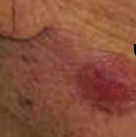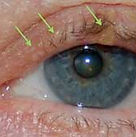DermaSurgery Center of Lancaster
Susan Teri McGillis, M.D.
To Schedule An Appointment
Call 717.399.9800
Skin Cancer Facts
-
Skin cancer is the most common cancer in the United States.
-
More than 1 million new cancers are diagnosed every year.
-
Melanoma represents only 4% of skin cancers but accounts for 75% of skin cancer deaths.
-
Most skin cancer appears after age 50, but tanning beds and lifestyle are causing these to occur at earlier ages.
-
Melanoma is more common than any non-skin cancer among women between 25 and 30 years old!
-
Sun exposure is known to induce skin cancer, but less than 30% of American adults use sun protection.
-
Skin cancer has a very high chance of cure if caught early.
If you have recently been diagnosed with skin cancer, you are not alone. Over one million people are diagnosed with skin cancer in the U.S. each year, making it the most common type of cancer. Fortunately, it is also one of the most treatable forms of cancer.

Actinic Keratosis (AK)
An AK forms when the skin is badly damaged by ultraviolet (UV) rays from the sun or indoor tanning. Most people get more than one AK. When you have more than one AK, you have actinic keratoses, or AKs.
AKs are very common and one of the most frequent reasons for seeing a dermatologist.
Anyone who has many AKs should be under a dermatologist’s care. Most people who have many AKs continue to get new AKs for life. AKs are considered precancerous. Left untreated, AKs may turn into a type of skin cancer called squamous cell carcinoma.
By seeing a dermatologist for checkups, the AKs can be treated before they become skin cancer. If skin cancer does develop, it can be caught early when treatment often cures skin cancer.

Basal Cell Carcinoma (BCC)
This is the most common type of skin cancer. It most often appears on skin that gets lot of sun, such as the face, scalp, neck, hands, and arms. You will find BCCs on other parts of the body, too. It can appear on parts of the body that did not get lots of sun, such as the genitals.
BCC often grows slowly. It may look like a:
-
Reddish patch of dry skin that won’t heal
-
Flesh-colored (or pink, red, or brown) pearl-shaped lump
-
Pimple that just won’t clear
-
Sore that bleeds, heals, and then returns
-
Scar that feels waxy — may be skin-colored, white, or yellow
-
Group of slow-growing, shiny pink or red growths — look like sores, often scaly and bleed easily
-
Flat or sunken growth — feels hard, may be white or yellow

Squamous Cell Carcinoma (SCC)
This is a very common type of skin cancer. It often appears on skin that got lots of sun, such as an ear, face, bald scalp, neck, or arm. But it can appear elsewhere — even inside the mouth, on the lip, or on the genitals.
Too much sun is often the cause, but it is not the only cause. SCC can appear on skin that was badly burned, had lots of radiation (such as x-rays), or was exposed to strong chemicals.
SCC often has a reddish color. Without treatment, it can grow deeply. If this happens, the cancer can spread to other parts of the body. This can be deadly. SCC often looks like a:
-
Hard (scaly or crusty) reddish bump, patch, or pearl-shaped growth
-
Open sore that itches and bleeds; it can heal and return
-
Scaly patch on the lip; skin on the lip can get thick

Malignant Melanoma (MM)
Know where you have moles on your skin! Melanoma often appears in an existing mole or looks like a new mole. By knowing where you have moles on your skin, you can find melanoma when it first appears. When treated early, melanoma is often curable.
Here’s what to looks for:
-
A mole on the skin that is growing, changing shape, or changing color
-
A mole that looks scaly, oozes, or bleeds
-
New dark spot on the skin that looks like a mole, but grows quickly
-
Pain, itch, or bleeding in a new spot on the skin
-
Streak (usually brown or black) underneath a fingernail or toenail
-
Bruise on the foot that does not heal

Merkel Cell Carcinoma (MCC)
Merkel cell carcinoma (MCC) is a rare skin cancer. It is also an aggressive skin cancer. MCC is considered aggressive because it can:
-
Grow quickly and spread.
-
Return after treatment.
Because MCC is aggressive, doctors recommend prompt treatment. The sooner this skin cancer is treated the better the outcome.Cases of Merkel cell carcinoma have tripled in the past 20 years.To improve a patient’s outcome, a team of doctors usually creates the treatment plan for MCC. This approach allows the patient to benefit from the expertise of specialists in different areas of medicine. The team often includes a dermatologist, a medical oncologist (cancer specialist), and a radiation oncologist (specialist in treating cancer with radiation.) Other doctors may also be a part of this team.It is important for patients diagnosed with MCC to:
-
Keep all appointments with their doctors.
-
Check their skin and lymph nodes for signs of cancer as recommended.
-
These actions help find cancer as early as possible.

Dermatofibrosarcoma (DFSP)

Sebaceous Carcinoma (SC)
Sebaceous (suh-bey-shuhs) carcinoma (SC) is a rare skin cancer. It is considered an aggressive skin cancer because it can spread.
Found early and treated, treatment is often successful. It is helpful to know that:
-
Most SCs begin on an eyelid.
-
You may notice a painless, round, firmly implanted tumor on your upper or lower eyelid.
-
Sometimes you have to pull gently on your eyelid to see the tumor.
This cancer may begin elsewhere. It can develop in any sebaceous gland. We have sebaceous glands on most areas of our skin. SC tends to develop in and around the eyes because we have the greatest number of sebaceous glands in that area.
This rare skin cancer can be mistaken for a stye or chalazion.
When this cancer begins in an eyelid, a dermatologist may refer to it as a meibomian (my-BOW-me-en) gland carcinoma. This is a unique type of sebaceous gland found in the eyelids.
Other growths develop on and around the eyelids. Most growths are benign (not cancer). If you notice a growth on your eyelid that remains despite treatment, you should make an appointment to see a dermatologist. The sooner this cancer is diagnosed and treated the better the outcome. If SC spreads, it can be deadly.
Dermatofibrosarcoma (dur-mah-toe-fy-bro-sar-co-ma) protuberans (pro-to-bur-anz) (DFSP) is a rare skin cancer. It begins in the middle layer of skin, the dermis. DFSP tends to grow slowly. It seldom spreads to other parts of the body.
Because DFSP rarely spreads, this cancer has a high survival rate. Treatment is important, though. Without treatment, DFSP can grow deep into the fat, muscle, and even bone. If this happens, treatment can be difficult.
As DFSP grows inside the middle layer of skin, it tends to push on the top layer of skin. You may see a lump.
The first sign of this skin cancer is often a small bump on the skin. It may resemble a deep-seated pimple or rough patch of skin. DFSP can also look like a scar. In children, it may remind you of a birthmark.
possible.

